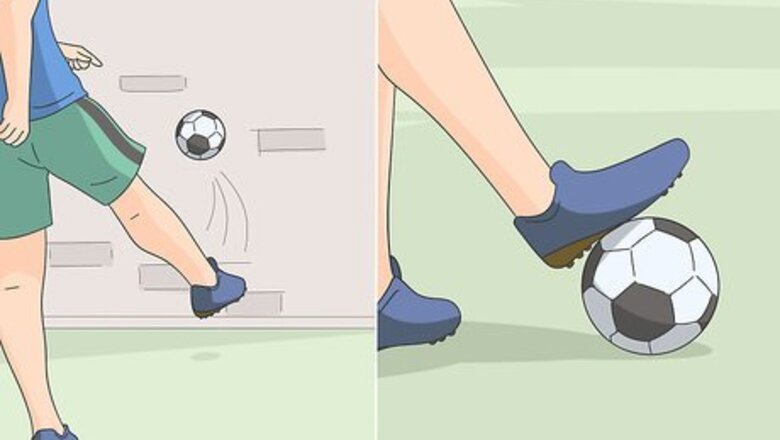
views
- Practice receiving a soccer ball by kicking it against a wall and stopping it with your foot when it comes back to you.
- Do dribbling drills, gently kicking the ball around the perimeter of your yard. Then, set up cones and dribble the ball around them.
- Stretch for 10 minutes before you practice to prevent injury. Focus on hamstring and calf stretches like lunges and toe-touches.
Handling a Soccer Ball
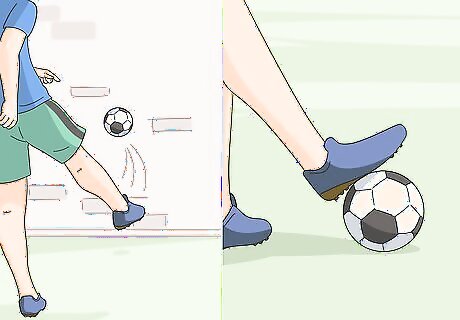
Practice receiving the soccer ball. Find a large, secluded brick or concrete wall. Simply kick the ball so that it hits the wall about 3 feet above the ground. As the ball bounces back, lift your foot into the air. Let the ball hit your foot, and fall to the ground. Do this over and over again for 10 minutes a day. It is important to not kick the ball. You are just raising your foot to where you think the ball will bounce back. Let the ball come to your foot. When you get the ball on the ground, put your foot on top of it to stop it from rolling away. Start each drill up close to the wall. As you feel more comfortable, gradually move backward. Wind up at least 30 feet away from the wall by the time the drill is done.

Juggle the soccer ball. It takes even the best soccer players years to master juggling a ball. However, it is a good way to get comfortable with handling a soccer ball and to improve your hand-to-eye coordination. Place the ball on the top of your foot so that it does not fall off. Lift your foot up in the air, letting the ball fly upwards. When the ball comes down, kick it back up into the air with your other foot. Make sure to hit the ball in the middle of your foot. If you don't, the ball could wind up hitting you in the face or flying off in the opposite direction. The goal is to maintain the ball near your body, about one foot away. To keep the ball from traveling very far, bend your knees upward when you kick the ball. Extending your leg will kick the ball away from your body. Do this drill for at least 10 minutes a day. It is okay if you only get 1 or 2 juggles at first. Keep trying and eventually your skills will improve. Try to at least get to 10 touches before you stop the drill.
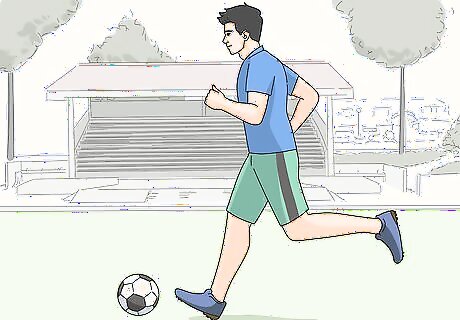
Begin to dribble the ball. Use your backyard and if you don't have a backyard go to your front yard. Travel around the perimeter of your backyard or front yard kicking the ball gently. Make sure that you are planting on the balls (upper part, not the heel) of your feet before you kick the soccer ball. Each time you kick the ball it should only go about 1-2 feet. Do this drill for 10 minutes, or until you have traveled around the field a few times. While soccer players use both feet to kick the ball, they also choose one as their primary kicking foot. This is usually the dominant foot, i.e. the foot that corresponds with the hand you primarily use (right-handed, use your right foot, etc.) This drill will help you figure out which foot you will primarily use to kick with. Your non-dominant foot will be used to plant and balance your body. When you are dribbling, it is important that your non-dominant foot stays relatively close to your body; otherwise, you could wind up kicking the ball farther than you want to. As you get more comfortable with dribbling, try to bring your eyes upwards. Your eyes will tend to look at the ball as you are dribbling, but in a game, you need to have your eyes up and looking around. It is okay if you accidentally trip over the ball in a drill, but you will gradually get used to not looking at the ball.
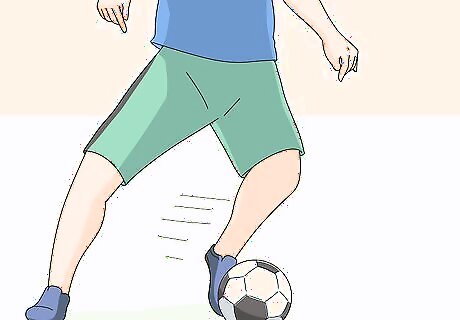
Turn the ball in different directions. While you can dribble left or right, you cannot get a sharp turn in direction merely by using the top part of your foot. This is where the sides of your feet come into play. First, dribble regularly for about eight feet. As you build up speed, get slightly ahead of the ball, and plant your dominant kicking foot. As the ball continues to roll, it will hit your planted foot, and ricochet in the direction you want it to go in. The direction you choose to turn the ball depends on the position of your foot. For example, assuming you use a right kicking foot, you will want the ball to hit the inside of your foot to make the ball go left, and the outside of your foot to go right. If you use a left kicking foot, you will want the ball to hit on the outside of your foot to make the ball go left, and the inside of your foot to go right. If you simply want to alter the ball's course, plant your foot and hold it steady. If you wish to significantly alter the direction of the ball, move your foot against the ball, giving it an extra kick towards the direction you want it to go in.
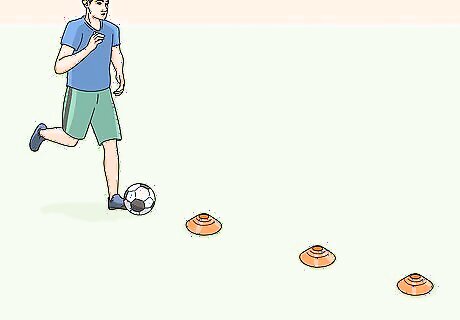
Dribble the ball around obstacles. Find a set of cones and place them in a straight line, at least 3 feet apart from each other. Begin to dribble around the obstacles. If the cone is on your left, and you use a right kicking foot, tap the ball gently with the inside of your right foot. Kick it hard enough so that it lands to the left side of the next cone. If the obstacle is on your right, and you use a right kicking foot, tap the ball with the outside of your right foot. Make sure that the ball lands on the right side of the next cone. These instructions are similar to people using their left kicking foot, except you will use different sides of your feet. For example, if the obstacle is on your left, tap the ball with the outside of your left foot. If the obstacle is on your right, tap the ball with the inside of your left foot. Practice with your non-dominant foot as well. This will help you keep control of the ball with both feet. After you have weaved through a straight line obstacle, you can change the cones up. Place them in a zig-zag formation, or place them randomly in the field.
Improving Your Skill Set
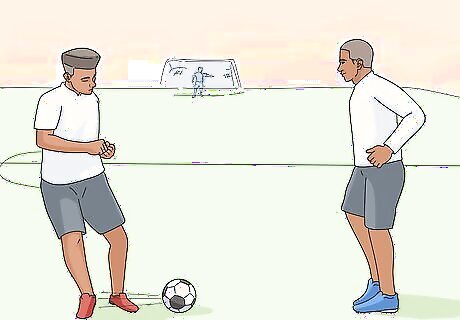
Pass the ball to your teammates. There are two major types of soccer passes, the ground and air pass. The ground pass is used most often, and for shorter distances. Have a friend or teammate stand about 20 feet away, facing you. A good ground pass uses the inside or outside of your dominant foot, not the point of your foot. Plant your non-dominant foot in the direction of the pass, right next to the ball. Then, swing your dominant leg back at mid-strength. As your dominant leg comes toward the ball to kick it, make sure that your dominant foot hits the ball with the inside of your foot and you follow through to stay accurate. The goal is to pass the ball to your teammate without the ball bouncing. You want the ball to stay on the ground all the way to your teammate. Pass the ball back and forth. Do this for 10-15 minutes each day. Make sure that you are aiming the ball right towards your teammate, as you will need to be accurate during a game. As you go along, you can increase the distance of your passing, from 20 feet, all the way up to 40 feet.
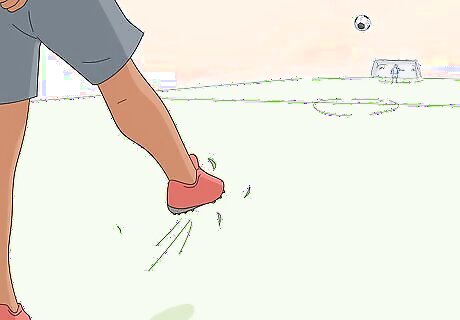
Send the ball further away. The other major type of soccer pass is the long ball. This is for when your teammate is 50 feet or more away. Instead of using the insides of your feet, you will use the top of your foot. Have a teammate stand at least 50 feet away, facing you. Back up a few feet behind the ball so that you can get more power behind the pass. As you move towards the ball, plant your non-dominant foot next to the ball, just like a ground pass. Swing your dominant leg backward at full strength. As your leg comes down, make sure that your dominant foot hits the ball right above your toes. This will give the ball the maximum angle and push it needs to get off the ground and travel far. Continue to tailor the strength of the pass. You might not need the full strength of your leg in order to make the long ball successful. Try to be as accurate as possible. Continue air passing with your teammate for at least 10 minutes a day.
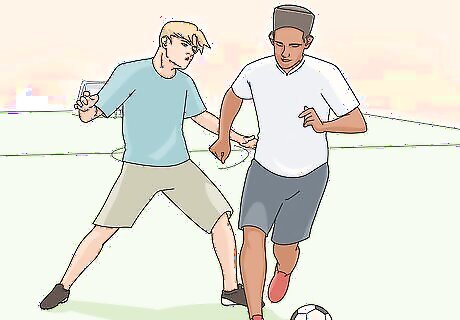
Keep the ball away from a defender. When you are playing a soccer match, the defender will try to come up, pressure you, and strip the ball away. In order to prepare for this, find a teammate to run a drill with. First, you will begin dribbling normally in an open field. Your teammate will then come up and run alongside you. Your teammate's goal will be to strip the ball away, while your goal will be to protect the ball at all costs. The best way to do this is to position your body correctly. If the defender comes up on your left side, shift your body to block the defender out. If the defender comes to your left side, move your body to the left to block the defender out. You can also use your arms to nudge your opponent out of the way. However, do not fully extend your arms or be overly aggressive; otherwise, you could wind up getting a yellow card. Do this drill for 20-30 feet. You can then switch back and forth to get a feel for both offense and defense.
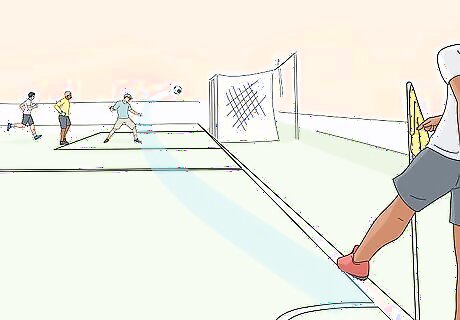
Kick the ball from the corner. When the soccer ball goes out of bounds on the endline where the goal is, the opposing team will get a corner kick. The goal of the corner kick is to make it curve towards the goal. Place the ball in the corner nearest where the ball went out. If you are simply practicing, you can do this in any corner. Step back at least three paces so that you have enough room to run up. Begin to run towards the ball. As you increase your momentum, plant your left foot on the left side of the ball. Swing your right leg back at full strength. When you kick the ball, you want to make sure that it hits the upper left edge of your right foot. This will create an arc in the ball's path so that it curves towards the net. Repeat this over and over again until you have the distance and power figured out. Have a teammate go out and try to head the ball into the net, or receive and kick it into the net.
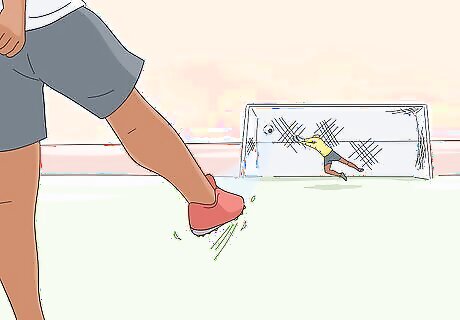
Score a goal. While there is no substitute for a real scrimmage to help you practice scoring, you can do some exercises by yourself, or with a teammate. Stand about 12 yards away from the goal, the distance of a penalty shot. Use the air passing technique, except you will be "passing" into the goal. Move back a few feet in order to get the maximum velocity and power. Run towards the ball. Plant your non-dominant foot on the side of the ball. Lift your dominant leg backward at full strength. As you bring your dominant leg down, make sure that you hit the ball right above your toes. Pick certain spots of the goal you wish to aim for. Try to get three consecutive shots to go in at that particular spot before you try another spot. You can also have your teammate stand there and pretend to be the goalie for an even more realistic situation. Move the ball to different places on the field. Vary the strength you put into your shots depending on the different distances you choose.
Perfecting Your Game

Shoot the ball with your head. Headers are usually used when a teammate is kicking from the corner. To practice this shot, have a teammate stand in front of you about ten feet away. They will loft balls underhand towards your head. Start off by doing a standing header. This means that your feet stay on the ground. Lean back as the ball comes towards you. As the ball gets even closer, bring your head back forward. Strike the ball directly on your forehead. Do this when your head is square with your body. For example, don't head the ball if you are leaning too far back, or too far forward. Do so when your head is in the normal, upright position. To perform a jumping header, do the same as before, except this time jump first. As you are jumping, lean your body back. Bring your head forward to meet the ball. Strike the ball with your forehead when your head is in the normal position, and when you are at the highest point of your jump. Do both the standing and jumping header drills ten times apiece. It is important not to overdo headers as they can cause you to have a concussion over time.
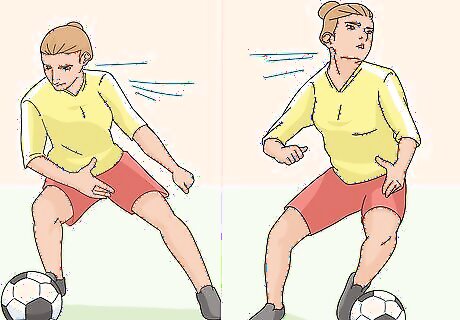
Shoulder feint during a match. This is probably the simplest move you can perform, but the effect is tremendous. Dribble the ball forward about 10-20 feet. As you approach a defender, tilt your shoulder to the left, as if you were headed in that direction. Then move the ball 45 degrees to the right, with the outside edge of your right foot. You can do the same in the opposite direction. Fade your shoulder to the right. Then move the ball 45 degrees to the left with the outside edge of your left foot. The defender will think you are going in one direction and be misdirected. After you have completed the move, continue to dribble past him or her. Have a teammate pretend to be a defender. Practice until you have at least completed the trick 10 times.
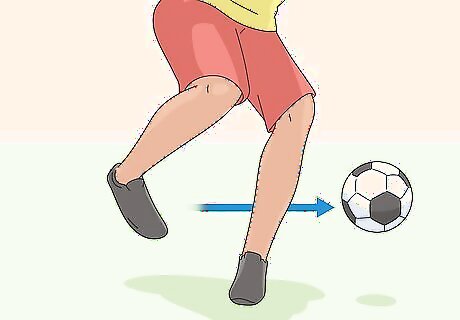
Perform a Cruyff Turn. The goal of this move is to catch the opposing player off guard. To practice, dribble with the ball a good 10-20 feet in order to build momentum. You will then want to fake like you are going to pass the ball. Take your non-dominant foot and plant it a few inches ahead of the ball. Then pull back your dominant leg, as if to kick the ball. Instead of kicking the ball head on, you will hit the ball with the inner edge of your dominant kicking foot. Kick the ball to the side, behind your already planted, non-dominant foot. Turn your body either clockwise or counterclockwise, depending on which foot you use to kick with. Find the ball and continue dribbling in the new direction. To practice, have a fellow teammate try and defend you. Keep the trick a secret and see if you can fake them out. Remember, this move only works when the defender is in front of you. Otherwise, the ball will travel right to your opponent's feet.
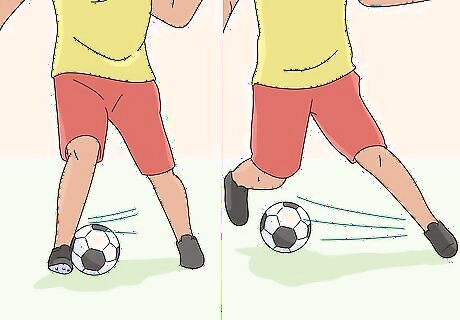
Master the scissors move. Like the Cruyff Turn, this move is designed to catch your opponent off guard. To practice, dribble the ball about 10-20 feet to gain speed and momentum. Plant your left foot on the left side of the ball, about a foot to the side. pull your right leg back as if to kick the ball. When you bring your right leg down, swirl your right foot around the ball, clockwise, without ever touching the ball. After you have completed the swirl, plant your right foot on the right side of the ball. Bring your left foot back, and kick the ball to the left. In order to get the opponent faked out to your right side, swirl with your right foot and kick with your left. In order to get your opponent faked out to your left side, swirl with your left foot and kick with your right. You can also perform a double scissors move by first swirling with your right foot, and then swirling again with your left foot. After you have performed both swirls, plant your left foot and kick towards the right direction with your right foot.
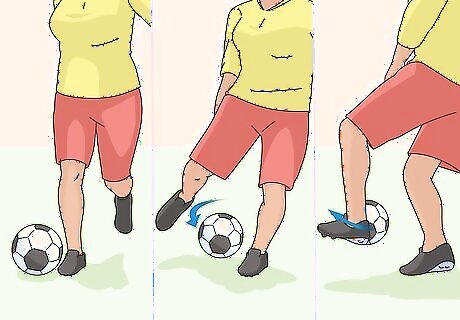
Use the Zico Cut during a match. This move allows you to fool the defender and power past them. Dribble the ball about 10-20 feet in order to create momentum. Plant your right foot to the right of the ball, about a foot to the side. Then, take the left edge of your left foot, and tap the right side of the ball (both feet are now on the right side of the ball). Maintain ball control with your left foot as you spin your body counterclockwise, moving your right foot with your body. After you have made a 360 degree turn with your body while maintaining control of the ball with your left foot, begin to dribble again. Your opponent will be caught off guard and be faked out in the opposite direction. You can also perform this move by going the opposite way. Simply plant with your left foot, while maintaining control with your right. Spin your body, and your left foot, clockwise until you have made a 360-degree turn. Continue dribbling after that.



















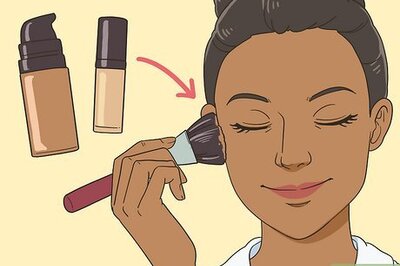
Comments
0 comment